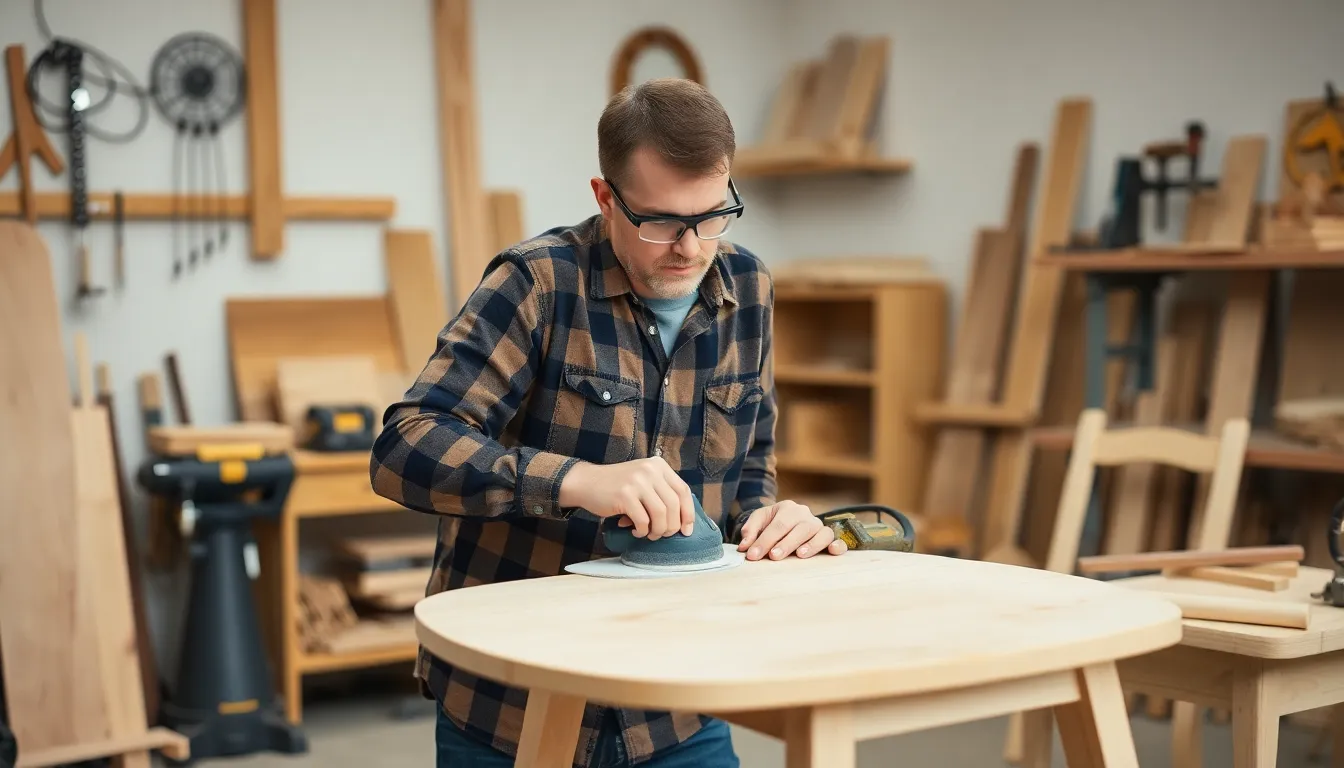Wood DIY projects are like the Swiss Army knives of home improvement—versatile, fun, and guaranteed to make you feel like a woodworking wizard. Whether you’re a seasoned craftsman or just looking to impress your friends with a handmade coffee table, there’s something satisfying about transforming a simple piece of lumber into a stunning creation. Plus, who wouldn’t want to wield a saw and hammer while channeling their inner Bob Vila?
Wood DIY Projects
Wood DIY projects encompass a wide range of creative endeavors. Homeowners might craft furniture, decorative items, or even functional storage solutions. Projects span various skill levels, allowing both novices and seasoned craftsmen to engage in meaningful tasks.
Crafting offers numerous benefits. For example, working with wood fosters creativity and enhances problem-solving skills. Completing a project can provide a deep sense of accomplishment, especially when it transforms raw materials into functional art.
Materials used can vary, but common choices include pine, oak, and plywood. Each type of wood adds its unique character and style to a project. Selecting the right wood can significantly impact the final product’s look and durability.
Tools are essential for successful woodworking. Basic tools such as saws, drills, and sanders enable individuals to cut, shape, and finish their creations. Investing in quality tools often leads to superior results and more enjoyable crafting experiences.
Planning plays a vital role in any DIY project. Drawing detailed sketches or using digital design software can help visualize the final outcome. Additionally, researching techniques and tutorials online often guides creators through the process.
Examples of popular wood DIY projects include building shelves, creating outdoor furniture, and designing personalized gifts. Completing these projects not only beautifies spaces but also often saves money compared to store-bought alternatives. Selecting a project aligns with personal interests makes the crafting experience even more rewarding.
Popular Types of Wood DIY Projects

Wood DIY projects provide endless possibilities for creativity and functionality. Various types of projects cater to different interests and skill levels, making woodworking accessible to all.
Furniture Building
Building furniture ranks among the most popular wood DIY projects. Options include crafting tables, chairs, and bookcases. The reward comes from transforming raw wood into beautiful, functional pieces. Knowledge of basic woodworking techniques makes this accessible to beginners. Advanced craftsmen can create complex designs with intricate joinery, enhancing their skills. It’s common for enthusiasts to customize sizes and styles, ensuring each piece fits perfectly in their space. Investing time into such projects often yields unique items that cannot be found in stores.
Home Decor
Creating home decor items offers a fantastic outlet for personal expression. Projects range from rustic picture frames to modern wall art. Many people enjoy crafting shelves or decorative signs that reflect their personality. Simple woodworking skills suffice for basic decor; however, more complex projects appeal to experienced woodworkers seeking a challenge. Seasonal decorations made from wood, like ornaments or centerpieces, add charm to any home. Often, the act of creating these pieces brings joy, while the finished products enhance the aesthetic appeal of living spaces.
Tools and Materials Needed
Wood DIY projects require specific tools and materials. Selecting the right equipment and wood types enhances the crafting experience and ensures better results.
Essential Tools for Beginners
Beginner woodworkers should acquire a few fundamental tools. A tape measure serves as a start for accurate measurements. A handsaw offers precision for cutting wood, while a cordless drill simplifies drilling holes. Sandpaper comes in various grits, perfect for smoothing surfaces. Clamps are essential for securing pieces during assembly. A square ensures right angles, and a level keeps projects straight. Investing in these tools builds a solid foundation for future woodworking endeavors.
Recommended Wood Types for Projects
Different wood types suit various projects. Pine ranks as a popular choice due to its affordability and ease of handling. Oak provides durability and strength, making it ideal for furniture. Birch works well for projects needing a smooth finish, while plywood offers versatility in crafting items like shelves. Cedar stands out for outdoor projects due to its natural resistance to decay. Selecting the right wood type influences both aesthetics and longevity, enhancing the final product’s quality.
Step-by-Step Guide for a Simple Wood DIY Project
Creating a simple wood DIY project involves several key steps. Begin by selecting a suitable project, such as a small shelf or a planter box, that matches skill levels and interests.
Gather essential tools, including a tape measure, handsaw, cordless drill, sandpaper, clamps, square, and level. Each of these tools plays a critical role in ensuring precision and ease during the building process.
Choose appropriate materials. Pine works well for beginners due to its affordability, while oak offers durability. Plywood serves great versatility in various projects and provides a smooth finish, while cedar is perfect for outdoor applications.
Sketch out designs before starting. Detailed plans clarify dimensions and design elements, making the assembly process straightforward and organized. Digital design software can assist in visualizing the final product.
Measure and cut the wood accurately. Use a tape measure to mark dimensions, following up with a handsaw. Ensure cuts are straight to fit pieces properly during assembly.
Sand all edges to create a smooth finish. Proper sanding enhances aesthetics and prevents splinters. Clamp pieces together before drilling to ensure stability.
Assemble the project by joining individual parts using wood screws or nails. Confirm that everything is square using a level to ensure structural integrity.
Finish the project with a protective sealant or paint. This step not only enhances appearance but improves durability, especially for outdoor items.
Finally, enjoy the satisfaction of completing a wood DIY project. Each step brings one closer to creating a beautiful, functional piece that adds character to any space.
Tips for Success in Wood DIY Projects
Selecting the right project provides a solid foundation for success. Evaluate skill levels and interests to ensure the chosen project engages and challenges without causing frustration.
Gathering quality materials impacts the final outcome greatly. Pine, oak, and plywood each offer distinct characteristics, so consider the project’s purpose when choosing.
Using the right tools is essential for achieving precision. A tape measure ensures accurate dimensions, while a handsaw allows for clean cuts. Additionally, a cordless drill simplifies assembly, and sandpaper helps smooth out rough edges.
Planning goes hand in hand with execution. Sketching designs or utilizing digital software clarifies the project’s vision. Visualizing the end result streamlines the process as it helps identify potential challenges.
Measuring and cutting wood accurately prevents costly mistakes. No one enjoys wasting materials, so take extra care with measurements. Following that, sanding edges prepares the surface for finishing touches.
Assembling the project is a crucial step that requires attention. Clamps secure pieces in place, ensuring stability during construction. After assembly, applying a protective sealant or paint enhances both aesthetics and durability.
Finally, celebrating the completed project provides immense satisfaction. Sharing the finished piece can inspire others and foster a sense of community among woodworkers. Engaging in these practices leads to rewarding experiences and stunning creations.
Conclusion
Wood DIY projects offer a unique blend of creativity and practicality that appeals to many. Whether crafting a simple shelf or an intricate coffee table, these projects provide opportunities for personal expression and skill development. The satisfaction of transforming raw materials into functional art is unmatched.
By selecting the right tools and materials, anyone can embark on a woodworking journey that not only beautifies their space but also enhances their problem-solving abilities. Celebrating each completed project fosters a sense of accomplishment and inspires others to explore their creativity. Embracing wood DIY projects not only enriches individual lives but also strengthens the community of makers.

